Industrial Work Table with Vintage Dictionary Top – Guest Post by Hammer Like a Girl
Y’all are gonna love today’s guest post! Hammer Like a Girl is in the HOWZZ! Check out that industrial book page topped table that they created.
Today’s guest post is brought to you by THREE handy gals! I’m seriously thinking about moving to Seattle just so I can be one of their friends and share in the DIY project co-ops. Heidi, Monica and Mary Jean make up the power trio at Hammer Like a Girl.
These ladies get together once a week to tackle a DIY project together. They rotate which house they will work in next. Check out some of their transformations like this oval to rectangle table transformation, rustic wood bathtub surround, or tile backsplash.
Many thanks to Brittany and her wonderful blog, Pretty Handy Girl. We are thrilled to be her guests!
We are three Seattle girls with backgrounds in graphic design, architecture, construction, and real estate – with a preference for rusty, worn, and modern. Once a week we get together at one of our houses and tackle a project together. We brainstorm, research, design, build – and we always have lunch.
HammerLikeAGirl.com was created to share our experiences in hopes of encouraging others. We’d love to hear what projects you are tackling. Just remember, when girls band together, anything is possible.
Below is just one of our recent projects. Making progress is kind of addicting so if you and friends dive in, remember to come up for air!
I had an old Ikea table top (that was basically like a hollow core door) that we used for a work surface in our office. It sat on top of an old table I found at a garage sale. It was all looking pretty shabby, and there was nothing chic about it.
First I painted the table base a dark charcoal gray, then together with my girlfriends, Mary Jean and Monica, we grabbed my grandmother’s old dictionary, a jar of Mod Podge, flat bar steel, galvanized bolts and washers, and went to work on the table top.
Materials:
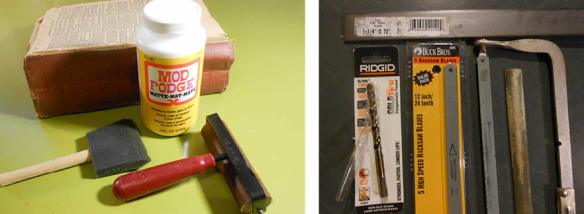
- Table top (I used an old Ikea table top)
- Mod Podge (for each coat that is applied, one pint/16 oz (473 ml) covers approximately 32 sq ft, one quart (.95 L) covers approximately 64 sq ft). There are several types of Mod Podge – the main 2 being gloss and matte. We used matte. Mod Podge is available your local arts/crafts store or onllne.
- Decorative papers (we used my grandmother’s old dictionary)
- Brayer (rubber roller used in printmaking, available at craft stores, or online.)
- Polyurethane (we used satin water-based Verathane)
- Flat bar steel (1/8″ thick x the depth of your table top – it is available in widths of 1″, 1 1/4″, 1 1/2″, 2″, available at your local hardware store or online.)
- Cobalt drill bit for metal (we used 5/16″)
- Galvanized lag bolts and washers (we used 1/4″ x 1 1/4″)
- Wood drill bit slightly smaller than lag bolts
- Hack saw with blade for cutting steel
- File for metal
Step 1 – Prep: Wash the surface with soap and water, let dry.
Step 2 – Design: Decide the design. We used my grandmother’s dictionary to cover the table, but you could anything that interests you – old wallpaper, your kids’ drawings, maps, wrapping paper, etc… Lay out the materials until you are satisfied with the design. Our idea was that the pages were going to overlap the edges and each other so we were not too worried about precision (and that made us happy). It also seemed to us since this was our first project like this, smaller sizes of paper would be easiest to work with.
Step 3 – Application of Mod Podge:
Start in a corner and wrap the pages around the edge about 1″. In 12″x12″ sections (or so), using a foam brush, generously apply the Mod Podge to the table surface and to the back of the paper. Lay the paper on the table surface and apply more Mod Podge on top as well. As you go, use a brayer, working your way from the center to the edges of each page, to flatten, and push/squeeze out the excess Mod Podge from beneath the paper. You can use this excess Mod Podge to spread out for your next section.

Apply Mod Podge to table, page back and front, use brayer to squeeze out extra Mod Podge and bubbles.
Work your way across the surface, blending the Mod Podge across the surface as you go. It is really helpful to have 2 or 3 people working together – one to spread Mod Podge on the table, one to spread it on the paper and one to use the brayer to make it lie flat. The Mod Podge is milky white when it is applied, but it will dry clear. If you get air bubbles trapped under the paper, prick with a pin and use brayer again.
Step 4 – Wait for it to Dry: Let dry for 24 hours.
Step 5 – Application of Verathane/Polyurethane Finish: If left alone, the Mod Podge surface will be slightly soft and tacky even when it dries, so it is best to apply a few coats of a polyurethane finish. We used water-based Verathane and applied 3 coats, letting it dry 4-6 hours between coats.
Step 6 – Cutting & Drilling the Steel Edge Pieces: Measure the 4 sides (carefully) and cut (carefully) the steel bar to size with a hacksaw with a blade for metal. Label the back corresponding to the correct table edge. Wear eye protection. It takes a little patience to work your way through the steel. Brace both ends of the steel so it doesn’t bow. File the edges so they aren’t sharp.
Measure and mark your bolt placement. We used 5 on the long sides and 3 on the short. Start in about 2″ from the corners so your bolts don’t hit each other (learn from our mistakes). Wearing eye protection, drill holes with a good drill (we used a plug-in drill, it has more power), using a metal carbide bit. Clamp your steel bar to a work surface and brace the end of the steel so it doesn’t bow. The drill bit tends to walk a little across the surface, start slowly to establish your hole and then start to press harder and harder. This also takes patience – you may want to practice on a scrap piece.
Step 7 – Attaching the Steel Edge Pieces: Almost done! Turn the table top on its side and position the steel on the edge. With a pencil, transfer your holes of the steel to your table edge. Set steel aside. Pre-drill the table edges with the wood drill bit. Make sure you use the correct drill bit size, not too big (again, learn from our mistakes). Place the steel edge piece on the table edge, using lag bolts and washers to attach. Use a socket wrench to tighten the bolts. Don’t over-tighten.
Repeat for each side, using a rolled up rug or cloth on the floor so you don’t damage the floor or your bolts.
All Done! This is a fun project, with plenty of leeway. If you mess up, you can just glue another page right over the top of your mistake.
It feels a little like being a third-grader again. Now we are looking around our houses for other things to cover with Mod Podge. Monica wants to Mod Podge her chicken coop, but we said no.
Thanks for having us over today.
Cheers!
Heidi, Monica, Mary Jean
Thank you gals! Seriously, can you believe how cool that industrial chic table is!!! I love the aged pages and the metal edging.
Hop over to Hammer Like a Girl and tell them I sent you ;-).
Do you want to be a guest on Pretty Handy Girl? Learn how to be my guest and have your blog featured.

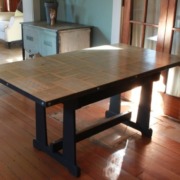

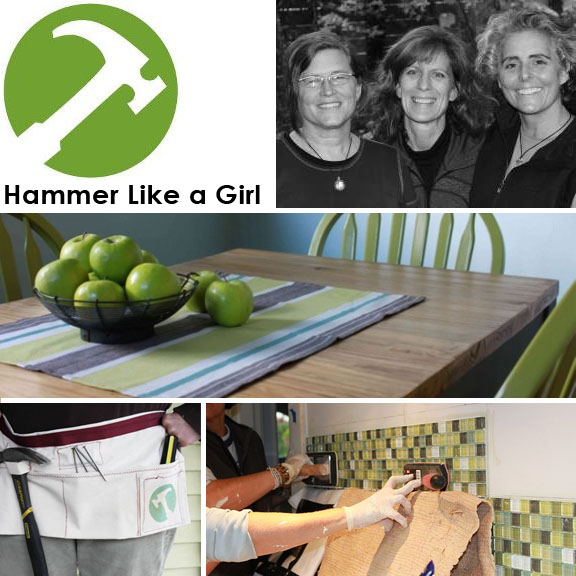

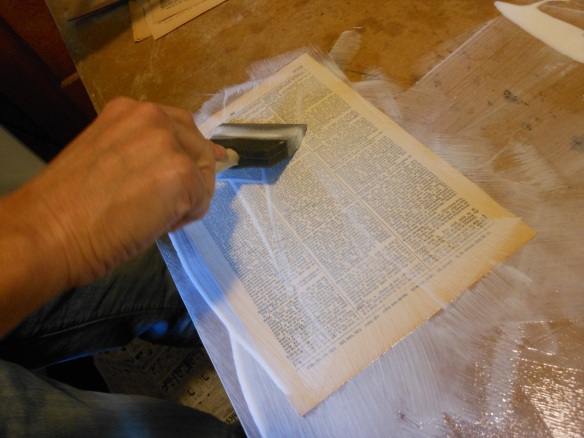



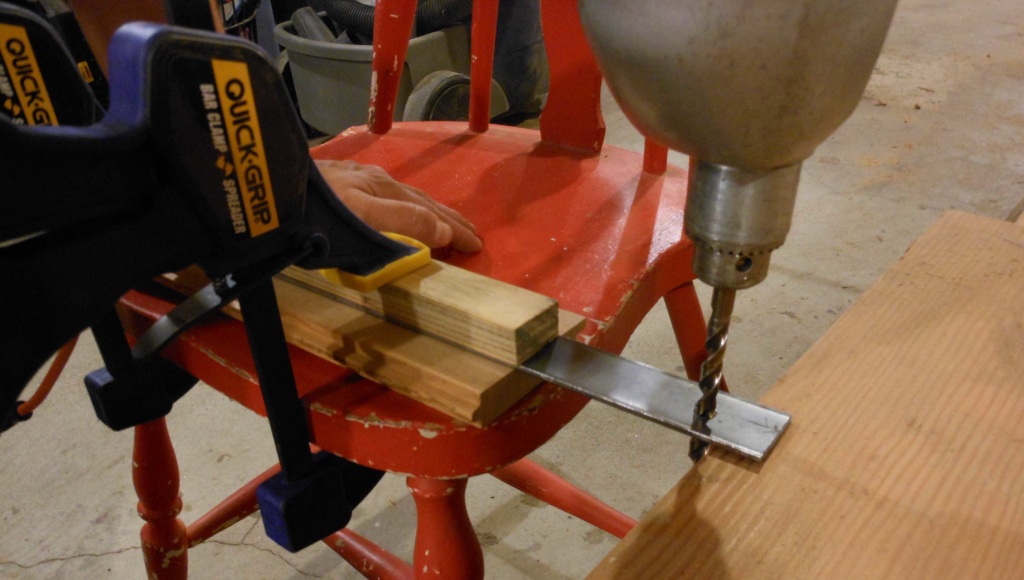






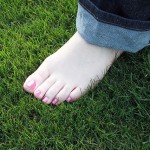
Beautiful job! I love the paper page top and the Poly makes it so durable!
Great project!
Susan
Homeroad
I have a fomica table that I would like to do this to-would a different prep be involved?
I have an old etiquette book with wonderfully yellowed pages just like that dictionary. I’ve been trying to get rid of it for years but I just couldn’t do it. Now I know why I’ve been saving it all these years! How awesome to have a desk to write your correspondence on while having antique advice underneath like how to iron or leave a calling card or talk to your maid.
LOVE this table and I say hey – go for the chicken coop (just use Outdoor Mod Podge! :D)
Love love love this! It looks so awesome
I’ve been searching for something cool to do to my desk top. This might be it! Thanks for the tutorial! Looks fantastic.
love this! you make it look so easy 🙂
I’ve read that if you Mod Podge the back of your paper and let it dry, before you Mod Podge it to your surface, you will have less air bubbles.